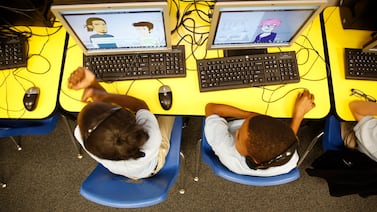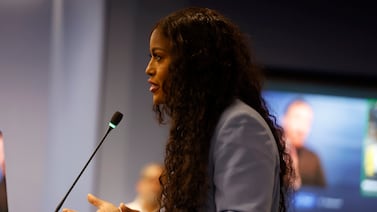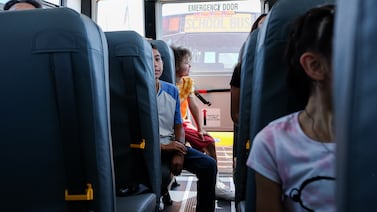Three of Colorado’s largest school districts — Denver, Jeffco, and Aurora — are grappling with the same problem: declining enrollment. But each is approaching school closure decisions differently.
The Aurora district has already closed eight schools over the last two years, with some still being phased out. Board members have struggled with the decisions, initially voting against two closure recommendations this year before reversing themselves.
Now the district is beginning a process to figure out what to do with the empty buildings, even as more closures are a possibility.
In Jeffco, after abruptly closing two schools in the last two years, a new administration recommended closing 16 elementary schools all at once at the end of this school year. The Jeffco school board is set to vote on that recommendation Thursday. The district will likely also recommend closing middle or high schools next year.
Denver has started, paused, and restarted a school closure process over the past two years. Ultimately, the superintendent recommended closing 10 elementary and middle schools at the end of this school year. The Denver school board is set to vote on Nov. 17.
Parents have a lot of questions about these decisions: How are schools picked for closure? Why are some districts closing so many schools at once? Why aren’t school districts considering academics or the role schools play in their communities?
Below, we answer some of the most common questions and break down how the three districts differ in their approaches.
What factors did the districts consider in picking which schools to close?
Denver and Jeffco based their decision mostly on enrollment, while Aurora considered a range of factors, including how school buildings might be repurposed.
In Denver and Jeffco, schools with too few students — fewer than 215 in Denver and fewer than 220 in Jeffco — were considered for closure.
Leaders in both districts also considered whether another school or schools within a few miles could take in the students from the closed school. For example, Denver spared four small schools because officials said there is no school within 2 miles that could receive their students.
There were other factors as well. In Denver, administrators wanted to make sure Spanish-speaking students would be able to continue bilingual or dual-language education. And in Jeffco, administrators also considered how much building space is being used.
Aurora, which started its school closure process in 2018, took a different approach. The district created seven regions and looked at enrollment trends in each zone, how many buildings the district might need, and which buildings could house new magnet programs or be used for other purposes.
One reason the community and board helped Aurora pick this approach is because the district is losing students in some regions while adding new subdivisions on the eastern plains. Leaders saw an opportunity to combine school closures with a larger strategic plan.
Why are Denver and Jeffco closing so many schools at once?
Declining enrollment isn’t a new problem. Leaders in Denver and Jeffco say delaying decisions in the past has led to schools that lack the resources to serve students well, despite substantial budget subsidies. Jeffco also wants to avoid emergency decisions that leave families reeling, such as happened at Allendale and Fitzmorris elementary schools.
In both Denver and Jeffco, the superintendent has asked the school board to vote on the closure recommendations as a package — all or none.
“We believe taking care of this in a rapid fashion will support our school community to do something really hard and then move on and create more thriving experiences for our students,” Jeffco Superintendent Tracy Dorland said.
Jeffco leaders also said they wanted to avoid making closure decisions every year, leaving families worried for a long time. In Aurora, a longer path with years of community engagement still left families frustrated and surprised by closure recommendations.
But Aurora Superintendent Rico Munn said taking the work in phases allows the district to track the impact.
“It’s a very dynamic field where we’re talking about student enrollment and demographic shifts — particularly post-pandemic,” Munn said. “We wanted to stop and reflect along the way.”
This fall, the district reopened two schools as magnet schools and is starting to track how the interest in those schools may affect enrollment throughout the region and the district. But it’s too early to know, Munn said.
Why wasn’t academics a factor?
Closing schools based on academics and test scores has fallen out of political favor, and none of the districts looked at performance in deciding which schools to close and which to save.
Superintendent Munn in Aurora said the state already has an accountability system that tracks school performance and can issue orders, including closure, as a consequence of not improving. “There wasn’t interest in creating a second one,” he said.
But that’s raised questions for parents and community members: Why close schools that are working for students?
What can school communities do to stop closures?
Not much, it seems.
Across the three districts, administrators have tried to avoid situations where parents, teachers, and community members rally to save their schools.
In Aurora, school board members gave into public pressure and rejected two closure recommendations only to reverse themselves two months later.
Board members, most of whom hadn’t been elected yet when Aurora’s Blueprint plan launched, wondered why the district didn’t consider how involved parents are in their school or how a school fit into its community context when making closure recommendations.
Munn said considering community involvement would be unfair. Parents working multiple jobs might love their school but not be able to attend meetings. Larger schools could turn out more parents to fight closure.
“Everyone wanted to avoid putting school communities against each other,” Munn said. “You don’t want to be creating a popularity contest.”
Denver and Jeffco have largely followed Aurora’s lead in this regard, and it’s one reason board members are being asked to approve closures as a package, not one by one.
Dorland, the Jeffco superintendent, went so far as to say community outreach won’t change the outcome. In Denver, though, some school board members seem troubled by the lack of opportunity for communities to address individual closure decisions.
How did community input factor into decision-making?
Of the three districts, Aurora had the most extensive community engagement process. But in all three, administrators ultimately decided which schools to recommend for closure.
Now Denver and Jeffco leaders are seeking feedback from parents and teachers on how to help the transition go smoothly — an approach that’s led to anger and frustration.
Aurora kicked off the planning for what became Blueprint in 2018 with consultants helping with surveys, focus groups, and community meetings. The district concluded that families wanted more school options, but that the choices should be provided by the district, not charter schools.
The district created regions with unique specializations and is developing new magnet schools to match those themes. The need for school closures — or “repurposing” — was embedded in this process from the start, though not all community members understood that. The district didn’t get a lot of pushback for the first rounds of school closures. This year parents fought back but ultimately were not successful.
Denver convened community groups starting in 2017. The Strengthening Neighborhoods Committee met with the goal of combating segregation in schools and addressing the effects of gentrification. One of its recommendations was a “transparent school consolidation process” that would allow communities to “reimagine” their own schools.
A second committee formed this year, the Declining Enrollment Advisory Committee, came up with school closure criteria that was applied to the most recent recommendation. But committee members were divided because many wanted to talk about avoiding the need for school closures — something district administrators said was not on the table.
Now Denver’s community engagement has moved to individual schools. Each principal is explaining the recommendation to their school community and doing their best to answer questions, a strategy that Superintendent Alex Marrero described as “intimate and intense.”
“I think the folks who they know and they love and adore and they follow are the ones who can tell them, ‘Okay, here’s the plan and here’s why it’s necessary,’” Marrero said.
The Denver school board will also host a single public comment session on Nov. 14.
In Jeffco, Dorland made clear that the community feedback would not change the recommendations. Community engagement was meant to address what families need to get through the transition.
Still, each school slated for closure has had an hour-long public comment session with the school board, adding up to at least 16 hours of public comment.
But in a report from the consulting group leading that work, it became clear families weren’t happy. Many still wanted to talk about the recommendations and have more questions answered, and Keystone Policy Center said they’ve encountered a lot of misinformation and a lack of trust in the process.
How did the districts decide on the timeline for informing parents?
Of the three districts, Denver’s timeline is the shortest, with just over three weeks between the recommendations announcement on Oct. 25 and the scheduled vote on Nov. 17. If the board votes yes, the 10 schools would close at the end of this school year.
But Denver Superintendent Marrero argued that the process actually started in June 2021 when the school board passed a resolution directing the superintendent to consolidate small schools.
The board needs to vote this month so there is enough time to operationalize the plan for next fall, Marrero said. He also said that slowing down the process would cause students and staff to flee the schools recommended for closure, exacerbating enrollment losses.
In Jeffco, families are getting more time than in previous emergency closures.
For instance, when the district closed Allendale and Fitzmorris, families were informed in the spring, with just weeks left before the school year ended and the school closed.
Families missed the first round of choice enrollment, and the district worked individually with families to place students for the next school year. This time, the Nov. 10 board vote is scheduled before the district launches its choice enrollment process for the year. If families want to choose a different school than the one the district recommends, they can.
Aurora has also increased the timeline between recommendations and closures.
In the first round of closures voted on in January 2021, the first school closed June 2021, with others phased out over time. In the second round of closures, the board voted in the spring of 2022 and schools will close at the end of the 2022-23 school year.
Did the districts consider how many students they might have in the future?
Yes. All three districts relied on analysis that takes into account factors such as birth rates, housing development, and mobility in predicting trends in school-age population.
In Denver, the most recent analysis, done this past spring, shows that the city has fewer children now than a decade ago. Births are declining fastest among Hispanic families, which the district predicts “will have a significant negative impact” on enrollment. Currently, a little more than half of the approximately 90,000 students in Denver Public Schools are Hispanic.
The analysis also notes that most planned or permitted developments are condos, apartments, and townhomes, which have historically yielded fewer students than single-family homes. But some community members, and even organizations such as the quasi-municipal Denver Housing Authority, are questioning Denver’s projections.
In Jeffco, a similar analysis presented to the school board Wednesday showed that students who come from families in poverty are leaving the district at higher rates than more affluent students. The two most common exit codes tracked by the district show students leave for other districts or to another state. District leaders said they suspect lack of affordable housing is pushing out families.
In Aurora, the number of students is projected to eventually grow again, but not necessarily in the same neighborhoods as in the past.
New housing developments are taking off in the eastern part of the district, which could call for new schools. Schools in the western part of the district, closer to Denver, continue to see steep declines as high housing costs push out families.
Originally, Aurora leaders expected enrollment to start growing by 2021, but Superintendent Munn said the pandemic sped up the declines in the west, changing the timeline. Growth is still expected, but the district is closely watching data to analyze when it might happen.
Melanie Asmar is a senior reporter for Chalkbeat Colorado, covering Denver Public Schools. Contact Melanie at masmar@chalkbeat.org.
Yesenia Robles is a reporter for Chalkbeat Colorado covering K-12 school districts and multilingual education. Contact Yesenia at yrobles@chalkbeat.org.







